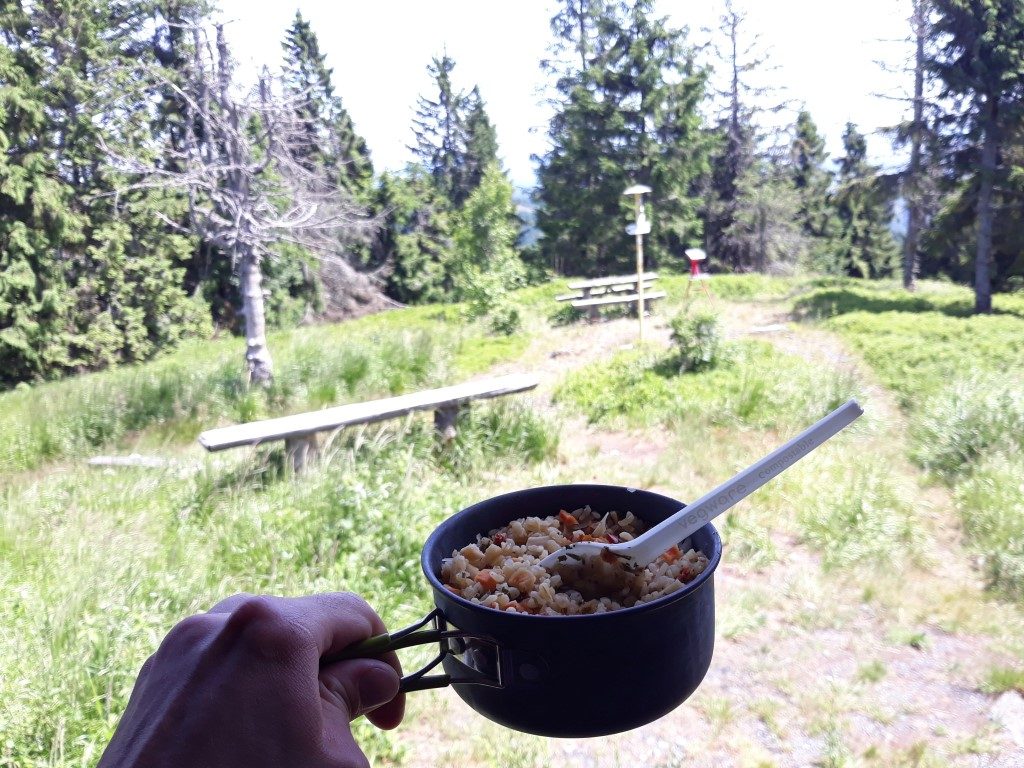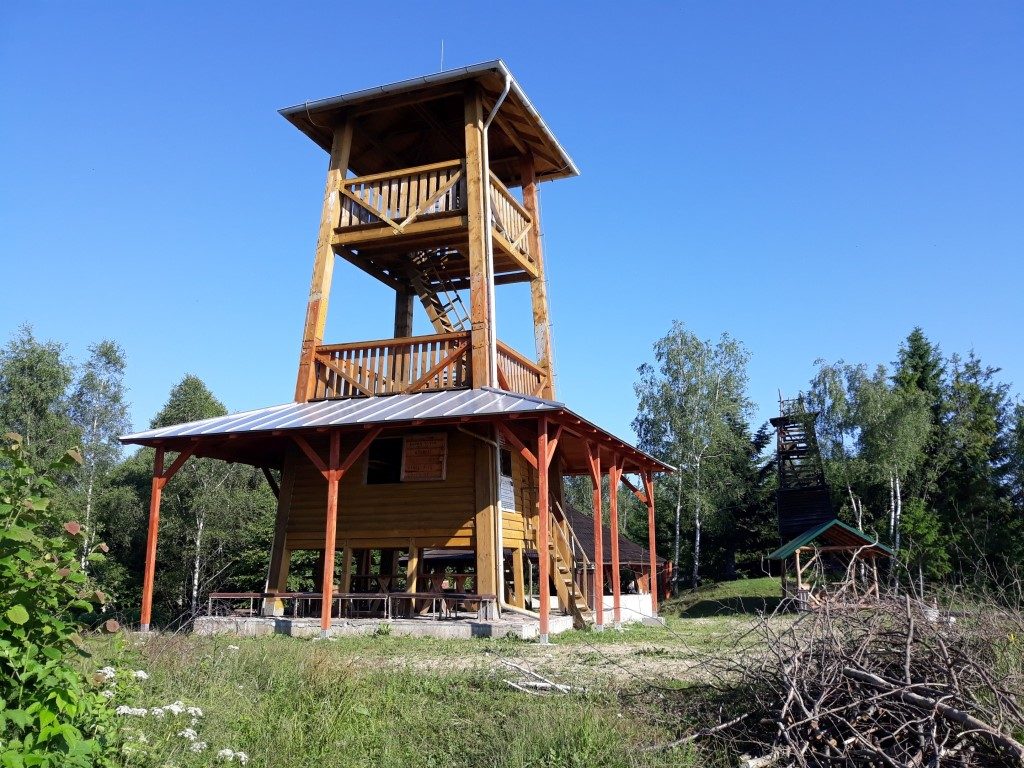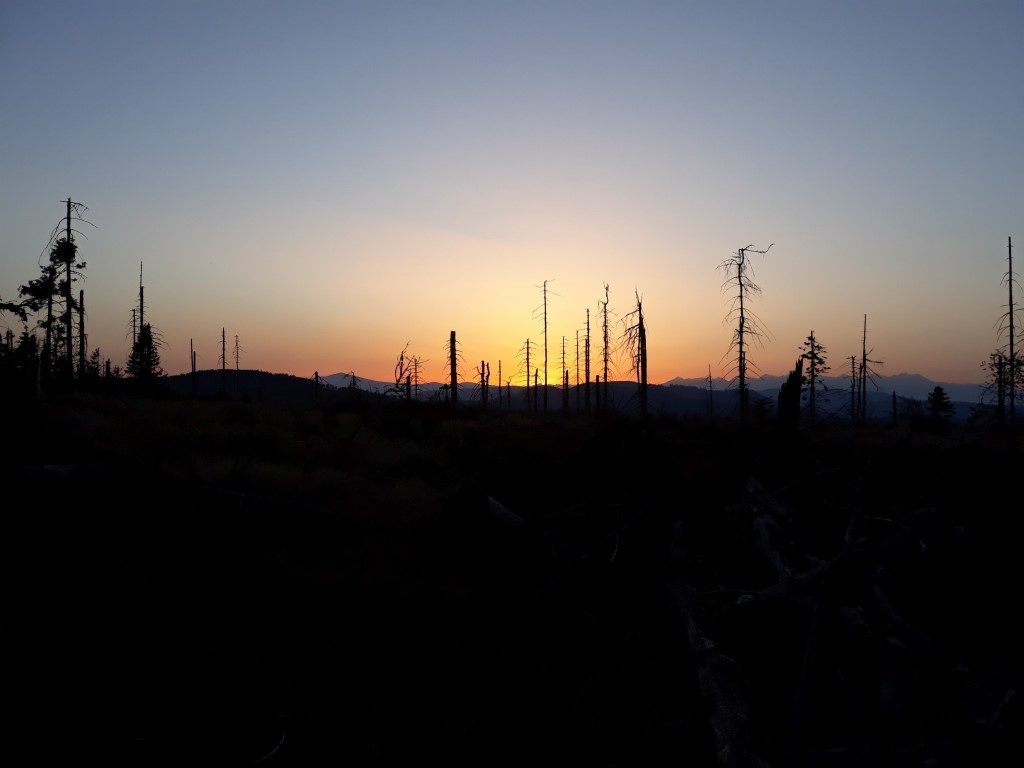On this page you will find the answers to the most common questions about the SNP Trail, as well as some interesting facts about the path. If you can’t find answer to your question either here or on one of the other pages, feel free to contact me. I will try my best to answer your question. Thank you!
Table of Contents
Section one: Technical Information about the trail
- Q 1: How long it takes to walk the SNP Trail? It takes about 28 days (with decent level of enjoyment and relax along the way). Fast hikers can do it in 22-25 days, and if you’re really slow or love to relax, it can take you up to 35 days. The fastest know time of walking (running) the trail is 7 days (Rudolf Pado, September 1992).
- Q 2: What’s the distance and the elevation profile? The trail is about 760km long, with up to 31,000 meters of elevation. You’ll walk mostly up and down (just like you’d imagine in the mountains), as the trail follows Carpathian mountain ranges, and ventures to valleys rather occasionally. The highest point is a peak Chopok in Low Tatras (2024 meters above see level) and the lowest is the final point of the trail near Castle Devin (145 meters above sea level).
- Q 3: When it’s the best time to walk the E8 path in Slovakia? In theory, you can walk the trail anytime during the year. However, since snow covers many peaks from October to May, and some mountain huts are closed in winter, the recommended time to walk the SNP trail is from the beginning of May to the end of September. If you prefer to sleep inside, however, and enjoy the comfort of all mountain huts, then you should opt for walking in July or August when virtually all huts are open (exception just proves the rule). Check the Accommodation page for more information.
- Q 4: How technical is the trail? In my opinion, the technicality of any trail depends strongly on your skills. I would say, however, that unless you walk in winter, the trail isn’t technical. There aren’t any climbing sections, you won’t scale ice-falls (or waterfalls), and while you may have to cross a few fallen trees here and there, it’s nothing that would make an experienced hiker sweat. I walked the entire trail in running shoes from Altra (Lone Peak 4.0). However, bear in mind the elevation. While you will walk mostly on beautiful trails in the forests, and enjoy the stunning views from the mountain ridges of Carpathian mountains, you’ll have to endure some extremely steep ascends and descends… While not technical, the trail definitely isn’t easy.
- Q 5: How good is the trail marking? Except of maybe two small sections, that could be repainted with new marks, the way marking could hardly be better. You’ll follow the same white-red-white rectangle, all the way from Dukla Pass to Devin Castle. Honestly, I spent quite a lot of time trekking in the Himalayas, in the Andes, in the Alps, and I hiked basically everywhere in Europe. In no country did I find a better way-marking network and quality of marks than the one we have here in Slovakia. So no worries, you won’t get lost!

Section two: Getting around, language, accommodation, company
- Q 6: How many people walk the E8 Path in Slovakia? We don’t have official statistics, but approximately 300-400 people start the trail each year, and about half of them will succeed and reach the end of the trail. However, the number of hikers you will meet varies a lot for various sections on the trail. In Low Tatra and Little Carpathians you may find yourself among dozens of other hikers, including foreigners (doing all kinds of daily/weekly hikes), while in some other sections, especially in the East of Slovakia, you’ll barely meet anyone during the day (except of crossing the villages–there you’ll meet locals, and they will offer you a beer or even something else…).
- Q 7: Do Slovaks speak English? Some do, and some do not. But generally speaking, they are very friendly to hikers and will use their arms and legs to get their message over to you :). The closer to Bratislava, the better the language skills of people. I still recommend you to learn at least some basic phrases (check the language school section), so you can get around and make it easier for the locals to understand you.
- Q 8: Where can I sleep on the trail? You can sleep in mountain lodges, guest houses, shelter huts, and you can also sleep in your tent (unless staying in a National Park, wild camping is allowed in Slovakia). Check the accommodation page for an in-detail list of places on the way where you can rest. Some people do actually walk this trail without caring a tent. There are many small shelters and places where you can comfortably rest in your sleeping bag. Check the equipment page for a recommended packing list.
- Q 9: Is it safe to walk this trail alone? Short answer is yes. If you followed other long-distance hikes in your life solo, you’ll be fine on this one as well. However, remember it’s a difficult hike with plenty of elevation to cover from Dukla to Devin. If you haven’t done anything similar before, or do not enjoy solitude in the mountains, you should rather look for a hiking partner.
- Q 10: How difficult is it to reach the starting point of the trail? It is not difficult at all, once you understand the local traffic connections. Check the travel section to see how you can reach both Dukla and Devin (the trail is marked in both directions, so you can start either from the East or from the West of Slovakia)

Section three: Food, wildlife, risks
- Q 11: Do dangerous animals reside in Slovak mountains? The only animal that can be dangerous is a Brown Bear. However, you won’t find a single recorded incident of a bear attacking a hiker on the SNP trail… Bears are shy animals. Once they sniff you, they will run away. I have seen some bear tracks while walking the trail, but haven’t spotted a bear, not even in the distance. If you are still afraid, however, you can carry a jingle bell or you can sing while walking the trail--just to ensure the bear will notice your presence and run away. You may sometimes spot a viper (venomous snake) on a trail, but unless you pick it up or step on it, it won’t bite you. Boars, deer, foxes, rabbits, chamois and other animals roam our forests and meadows, and if lucky you may spot them on the trail.
- Q 12: What about dangerous people? Just like in any other country of the world, you’ll find some strange characters in Slovakia. But these people are concentrated in big cities, and you won’t really meet them on the trails. Theft, or other form of criminal activity, is very rare in the mountains. Anyway, Slovakia ranks 23. in global peace index. Just for comparison, Spain is no. 32, UK no. 45, Nepal no. 78, and US no. 138. It’s much safer to do hiking (or traveling) in Slovakia than it is in many world famous tourist destinations.
- Q 13: Is Slovakia a vegetarian/vegan friendly country? Can I meet my dietary needs on the trail? Only about 1.5% of Slovaks are vegetarians/vegans. This reflects strongly in the offer of local restaurants and mountain huts. You will find barely any vegan options (except of some vegan places in big cities), but you will always get something vegetarian (potato dumplings with cheese, garlic soup with bread, pancakes, etc). The situation is much better in grocery stores. In bigger stores you’ll find almost any plant-based products you enjoy back home (tofu, hummus, all kinds of vegetables, fruits, legumes, etc). I am vegetarian and I didn’t find it hard to follow my diet on the trail.
- Q 14: How expensive is the food/accommodation in Slovakia? This varies a lot from one place to another. A typical budget for the SNP trail is about 30-40 euro/day. Of course rovers or people who are tight on budget can walk it even for 5-10euro/day, sleeping always in tent and never dining in restaurants, eating very basic food all along the way. The typical price for a menu starts at 4euro, in some places, and can go up to 15-20, depending on the location and time of the day. In some mountain huts you’ll get a bed for as little as 7 euro, but you can also stay in some relatively luxury hotels/apartments, paying 50 euro or more for a room… See Accommodation section for more details and for individual prices. To sum it up, you can walk it spending almost nothing, but to have a more enjoyable experience prepare 1,000 euro for the hike.
- Q 15: Are there storms in Slovakia? We have storms, mostly in the summer months. But this depends strongly on the season. Read the following article if you do not know what to do when you encounter a storm in the mountains.

Section four (temporary): Covid-19 related info
- Q 16: Can I come to Slovakia as a foreigner during the “pandemic”? Do I need to quarantine upon my arrival? Just like in most other European countries, the conditions keep changing, almost on a weekly basis. You can consult the information on the official websites run by the government, here, or here. At the time of writing these lines, however, (late May 2021) you have to quarantine yourself for 8 days at least, unless you are vaccinated, or have overcome the illness during the last 180 days. And you will always need to take a PCR test. However, the conditions keep changing, and I hope that from mid-June, or the beginning of July latest, it will be possible to start walking immediately upon your arrival–as long as you have a negative test result with you, no older than 72 hours.
- Q 17: How bad is the situation with covid-19 in Slovakia? Just like in almost any other country of the world, the situation is much better than the fear-mongering media try to depict it. You do not need to worry about being refused in a hospital–in a case of an injury sustained on a trail for example, because all beds would be occupied by people dying from the virus… It is not the case, and it has never been the case here in Slovakia.
- Q 18: Are hotels, huts, restaurants, and other facilities open during the “pandemic”? We have some restrictions in place, and they keep changing constantly. At the time of writing these lines (late May 2021) you can eat in restaurants, but you have to sit outside (on a terrace), grocery stores are open normally, you will get accommodation in most huts/hotels, and there is no curfew in place. Pools and spa complexes are closed for general public. However, with summer approaching and the daily/weekly number of new “infections” continuing to decrease I expect the authorities to lift the restrictions almost completely until July.
- Q 19: How strictly do the authorities control the adherence to the rules? Not very strictly, to say the least. Officially, at the time of writing these lines, I need a negative antigen test to enter any office (post office, tax office, etc), any retail establishment except of a grocery store or a pharmacy (such as fashion, apparel, electronics), to visit a restaurant, etc. However, nobody has ever asked me to show them the test, with a sole exception of my dentist. The only rule that is controlled to some extend is wearing a mask (a respirator) indoors, in shops, offices, public transport, etc.
- Q 20: I am not afraid of a respiratory virus with a death rate below 0.1% in healthy people under 65 years of age. Can I just come with a negative PCR test and walk the trail, ignoring the restrictions and ridiculous quarantine rules completely? Sure you can, but you have to bear the risk of being interrogated and potentially fined (up to 1,000 euro–a fine you can refuse to pay though), or even deported from the country. Of course, the chances of it happening are extremely slim. You will walk mostly in the mountains, and the chances that anyone will ask you to show them some test result, or a proof of a quarantine, are close to zero. Nine out of ten police officers in Slovakia do not speak any English, and they will not embarrass themselves trying to talk to you (unless you commit a real crime, such as stealing something in a shop, but I am sure that’s not why you want to come here :)). What’s more, many officers do not support the restrictions, and logically won’t bother you with any requests. To sum it up: You can walk the trail without obliging to the quarantine rules presently in place. But you have to count with a small risk of not being able to finish your walk because of it. At the end of the day, you are the one responsible for your decisions and actions, and may be held accountable for them. Keep in on your mind whatever you decide to do…

Section five: Miscellaneous
- Q 21: Can I walk the SNP Trail with a dog? Most definitely you can! Most huts and B&B do not accept dogs (on the list of accommodation on the way you will find some dog-friendly options though), and it is better to carry a tent if you want to take your beloved dog with you on this journey. Asphalt covers less than 10% of the overall path length, and most dogs will enjoy the journey immensely. The best time to walk with a dog is in May or September, since July and August are typically very hot, and dogs may find certain sections of the trail strenuous, or almost unbearable…
- Q 22: Can I buy camping gas in Slovakia? You can, but you should purchase it before starting the hike, either in Bratislava (when starting your hike from Devin Castle), or in Kosice (when embarking from Dukla, you will change train for a bus in this beautiful city). Just ask in any shop with hiking gear. They will either have the camping gas, or they will recommend you a place where you can get it. Hiking and camping are popular in Slovakia, so it is not difficult to get any kind of equipment you may need. You may find gas bombs also in one of the mountain huts/small villages along the way, but do not rely on this option… If you try to get one and can’t find the place, send me a message. I will find the nearest shop and send you the directions, or I will bring you the bomb, if you happen to be close to my place :).
- Q 23: Is it possible to do the E8 path in Slovakia on a mountain bike? Few people (perhaps less than 10) have done it before, but I would not recommend it. What’s more, it is forbidden to ride a bike on certain sections of the trail (for example in the Low Tatra national park). You will also have to carry your horse quite a bit, which is not fun when you have luggage, and the bike wights 25 kilos. Think twice before taking your bike. You may as well return back home without it…
- Q 24: What is the situation with the water? Is tap/spring water drinkable? One of the best things about this trail (when I compare it to many other trails I walked abroad) is the abundance of fresh water. You have plenty of springs along the way (check maps & stages). The water is not only drinkable. It is delicious, and you may find it better than any water you’ve tasted before. When doing this hike I never carried more than three liters of water, sometimes less than one liter. Tap water is also drinkable, everywhere in Slovakia.
- Q 25: Do you recommend any mobile application to help with navigation on the trail? If you do not have your favorite application yet, I recommend either mapy.cz, or maps.me. They both have their advantages, it’s up to you to choose :).
- Q 26: You didn’t answer my question on this page. What should I do? Browse the homepage, and perhaps also other sections on the website. If you still cannot find the answer, write to matejvaluch133[at]gmail[dot]com . I will try my best to answer any questions you may have…
Enjoy the trail!